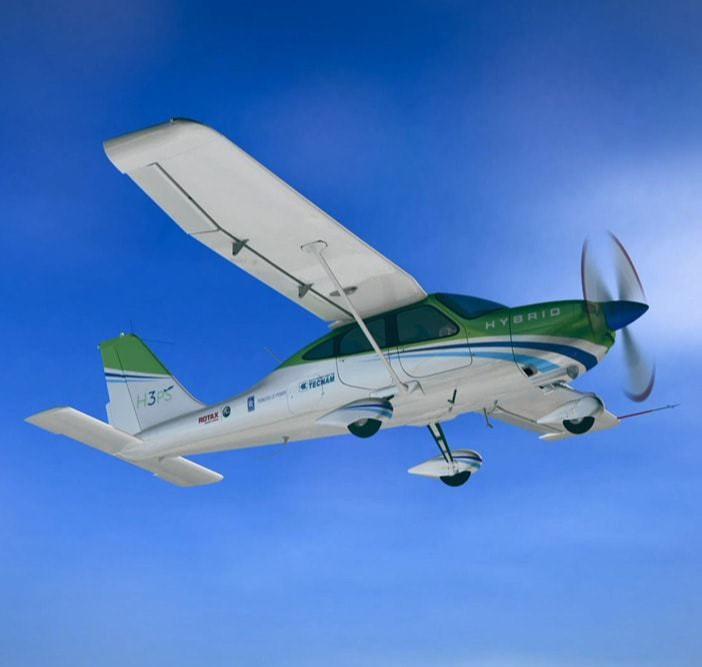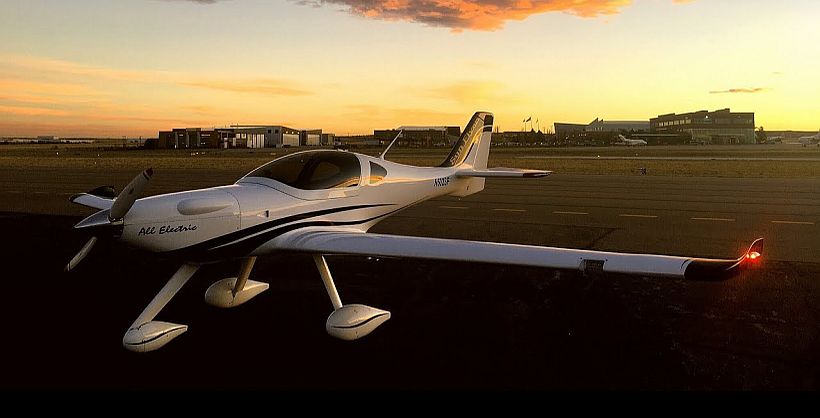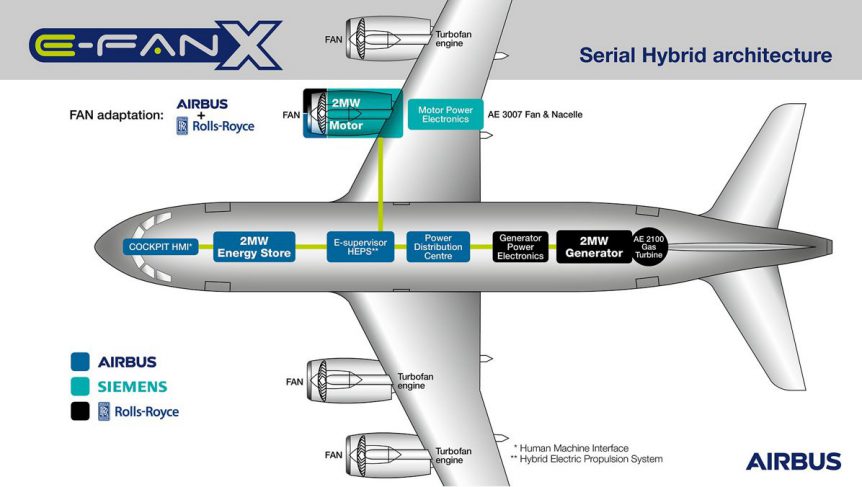Tecnam, an Italian aircraft producer noteworthy for supplying the base aircraft for NASA’s X-57 Maxwell distributed electric test vehicle, has two of its own electric craft under development. One will be a parallel-hybrid single-engine/motor four-seater with perhaps the smallest motor Rolls-Royce can supply. The other will employ a battery-only system to power an 11-seat commuter aircraft. Tecnam’s history, starting in 1948, includes the design and manufacture of over 33 types of aircraft, with deliveries of over 5,500 airframes in more than 65 countries. Parallel Power Introduced in 2018, the H3PS (“High Power High Scalability Aircraft Hybrid Powertrain”) project was a collaboration among Tecnam, BRP-Rotax and (at the time) Siemens, which supplied the electric motor. Siemens’ electric aircraft division has since been purchased by Rolls-Royce, taking over the motor part of the H3PS partnership. The setup is similar to that employed by Axter Aerospace, a Spanish company, in 2015. The video presents the different modes of power available, but Creedence Clearwater …
APUS Introduces Two Zero Emission Craft
We’ve written several times about structural batteries in this blog, from Dr. Emile Greenhalgh’s early research at Imperial College to more recent efforts along the same line. Interestingly, the basic idea remains very much the same over a decade. Energy storage would take place in a monocoque-type structure that could use carbon fiber, fiberglass, and even graphene as a structural material, while acting as a battery. Now some of this thinking is being applied to hydrogen storage in wings. “TubeStruct™” APUS, an aircraft design, structure and certification operation in Strausberg, Germany, offering a full range of services including flight training. They recently announced two new craft, both featuring hydrogen fuel systems contained in a novel “… patented structurally integrated hydrogen storage system, known as TubeStruct™.” In the shadow drawings of the airplanes, the tubes appear as though they could double as redundant wing spars. The i-2, a four-seat Normal-Category (CS-23) aircraft; and “The APUS i-6 is a technology demonstration platform …
Sun Flyer 2 to be Powered by Siemens Motor
George Bye has been enjoying a year filled with great expectations (and accomplishments). With 121 deposits on the Bye Aerospace Sun Flyer 2 from seven countries, the training aircraft needs only two things to make dreams come true for a large number of people – a motor and FAA certification. Siemens Steps In In a joint press release, Bye, CEO of Bye Aerospace, announced a partnership with Siemens that will see the German firm “collaborate on future development of Bye Aerospace’s Sun Flyer 2.” Bye explained, “We are pleased to announce an agreement with Siemens to provide the electric propulsion motor and inverter for the Sun Flyer program. They will be an active partner through the FAA certification and production phase for the Sun Flyer 2.” Siemens will supply the two-seater with its SP70D motor with a peak output of 90 kilowatts (115 hp.) and a continuous rating of 70 kW (90 hp.). Bye explained the nice “fit” with the …
Rolls-Royce, Airbus and Siemens Team Up on Hybrid Airliner
As many of your editor’s friends know, he is often lured to trolling the tabloids, looking for juicy bits about the royal family or Hollywood royalty. Recently, while perusing the Daily Mail* for news of the upcoming Harry/Meaghan nuptials, he came across the big-headline news that three European power players – Rolls-Royce, Airbus, and Siemens, are collaborating on creating a testbed for a hybrid power system. The trio will take a Bae 146 four-engine regional jet, convert it to a hybrid demonstrator by 2020, and have a production plane in place by 2030. The high-wing airplane has four turbofans in place now, but the partners will replace one with a Siemens two-megawatt electric motor powered by a Rolls-Royce two-megawatt generator in the plane’s cargo hold. The UK paper reports, ”The companies said they were looking ahead to the European Union’s long-term goals of reducing CO2 emissions from aviation by 60 percent, as well as meeting noise and pollution limits that …
Good News and a Bright Future from EAS IX
Sitting next to your editor for the first day of CAFE’s ninth annual Electric Aircraft Symposium, Paul Bertorelli from AVweb, took copious notes, made sound recordings, and during coffee and lunch breaks and in after-hours sessions, interviewed the accomplished faculty at the Symposium. His thorough and far-reaching reports appear in his last several days’ postings to AVweb. Having stressed mightily while attempting to take understandable notes from each speaker’s talk, your editor can only be impressed by Paul’s super reportorial abilities, and his communicating the scope and importance of what took place at EAS IX. From your editor’s perspective, several significant things took place this year. Senior leadership from Airbus and Siemens presented talks affirming their companies’ commitment to making progress in electric aviation, with future plans to develop two and four-seat aircraft for European and American markets from Airbus, and to produce a range of light-weight, commercially-available motors from Siemens. Siemens has 343,000 employees worldwide and revenues of 101.2 …
Siemens Makes a Big, Light Motor
Its 14 kilogram (30.8 pound), 85 kilowatt (114 horsepower) motor already graces the nose of the PIpistrel WattsUp, and Siemens seems to have expanded its aeronautical offerings with its new 50 kilogram (110 pound), 260 kilowatt (348.5 hp.) unit. According to Dr. Frank Anton, Head of eAircraft at Siemens Corporate Technology, the new motor “make[s] it possible to build series hybrid-electric aircraft with four or more seats.” Siemens claims a world record of five kilowatts per kilogram, although Roman Susnik, with his Emrax motors pulling close to 10 kilowatts per kilogram, might contest that, and LaunchPoint is working toward eclipsing that mark. To be fair, it’s certainly a giant boost over the power-to-weight ratio of most industrial-type electric motors, which Siemens also produces in large numbers. The company, according to its press release, intends to start flight testing the new motor before the end of this year, and hopes to increase output even more. In 2013, Siemens partnered with Airbus …
Fastest Electric Vehicle Design at EAS VI
Dr. Brien Seeley, President of the CAFE Foundation, has made the following announcement: “The Chief designer of the F-22 Raptor has prepared another spectacular design: The World’s Fastest Electric Vehicle. This new aircraft design will be presented along with the other outstanding talks at next week’s CAFE Electric Aircraft Symposium, April 27, 28 in Santa Rosa, California (Sonoma Wine Country). This symposium, dedicated to the burgeoning new domain of emission-free flight, now has representatives from Boeing, Bosch, IBM, Honda, Nortrhop-Grumman, Japan Air Lines, Rolls-Royce, Siemens, Aerovironment, FAA, Cummins, Cessna, Lycoming and many other companies enrolled to participate.” The high-speed electric may be a response to Ivo Boscarol’s pledge to put up $100,000 of his Pipistrel G-4 winnings at last year’s Green Flight Challenge for the first supersonic electric aircraft. Program Details can be found here. There is still time to pre-register online here.




